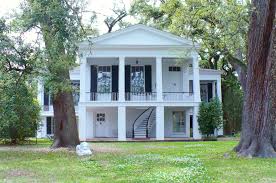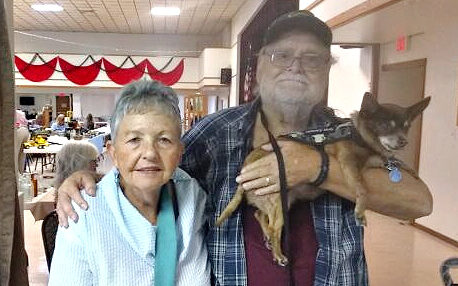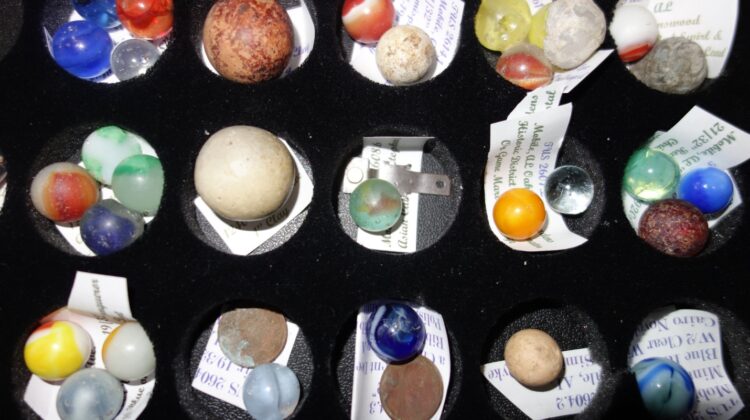
Photograph by Jo Garrett
People often ask how we got started looking for marbles.In the mid 1990s we were living in Al Ain, Abu Dhabi, United Arab Emirates. “Al Ain” is “The Spring” in Arabic. There were about 225,000 people living in the thriving City at the time. It is also known as the “garden city.” There is a large Oasis and we will never forget the sweet smell of the thousands of petunias in the garden of the Governor’s Palace which is now known as the Sheikh Zayed Palace Museum. And we visited the nearby ancient camel market as often as we could.
We have always loved exploring and while in the Emirates and Oman we spent as much time in the deserts as possible. A wadi is a valley, or more commonly, a streambed. Wadi Tawiyyah is near Al Ain, which is in Eastern Abu Dhabi Emirate. We explored this area time and again and we did find one blue and white glass marble. We believe it was lost by a British expatriate child.
Back Home
We returned to the states for good in 2001 and we bought a home in Pensacola, Florida. Now we started our search for marbles and other artifacts in earnest. We were fascinated by our finds in Pensacola. Pensacola Bay, Santa Rosa Island, and the surrounding area was explored by the Spanish in the 1500s and the City was founded by the Spanish in 1698. Besides the Spanish, it has been controlled by France, Britain, the United States, and the Confederate States of America.
We were fascinated by what we could find on the surface! For example, we found an ancient drag from a sword scabbard ord and a glazed American pipe bowl in Pensacola Bay. The bowl was unusual because it was glazed green. The green hue in the glaze came from copper oxides. The bowl was American, and the stem would have been a reed! Professionals dated the bowl to the ca. 1820s.
By this time we both suffered some degree of disability and it was too painful to enjoy using a metal detector. And our days of digging were over.
We have nothing but respect for people who are able to dig and metal detect. Everyday we see posts online about what they find at 8’, 10’, and more. And some of their hauls include fifty or more artifacts from the same site! We even read one story in which the diggers went 30’ and used a ladder to climb in and out of a privy hole! Old privies are one great source of artifacts. You might want to check our story “You Dug It Up Where?” (https://thesecretlifeofmarbles.com/you-dug-it-up-where/).
Getting Our Toes Wet In Archaeology
Larry volunteered at the University of West Florida and he took a course in Archaeology. He was also trained to identify, sort, and properly catalog Native American and historic artifacts in the archaeology lab class. He participated in summer school digs for over five years. We decided to apply the principles of archaeologically site surveys to find marbles on our own.[1]!
And we did find marbles using these practices and principles! Eventually, we found 23 marbles in Pensacola. Most were mid-20th century glass but some were colonial white clay. Chapter 4, “Pensacola Canicas Para Oficiales Militares?” in our book The Secret Life of Marbles Their History and Mystery (The Secret Life of Marbles: Their History and Mystery: Garrett, Larry N., Garrett, C. Joanne: 9798351554570: Amazon.com: Books) is all about our marble searches and surface finds in Pensacola.
We never stopped looking for marbles and other bits and bobs as you can see in our feature photograph. So far we have found 2,867 marbles in 246 communities! You might want to check out our story “Far Flung In Wimauma” https://thesecretlifeofmarbles.com/far-flung-in-wimauma/ We were not looking for marbles when we saw the little cabin below. While there were places we could look in the general area, we approached this cabin only to take photos and kept a respectful distance.
This abandoned home is on Mon Luis Island in Mobile county, Alabama. The island was first settled in the early 18th century by French Louisiana colonists. A land grant was made to Nicholas Baudin, Sieur de Miragouane in 1710. The island was named in honor his son, Louis Alexandre Baudin. It is very near the Hiram B. Austin House, which was built in 1837.
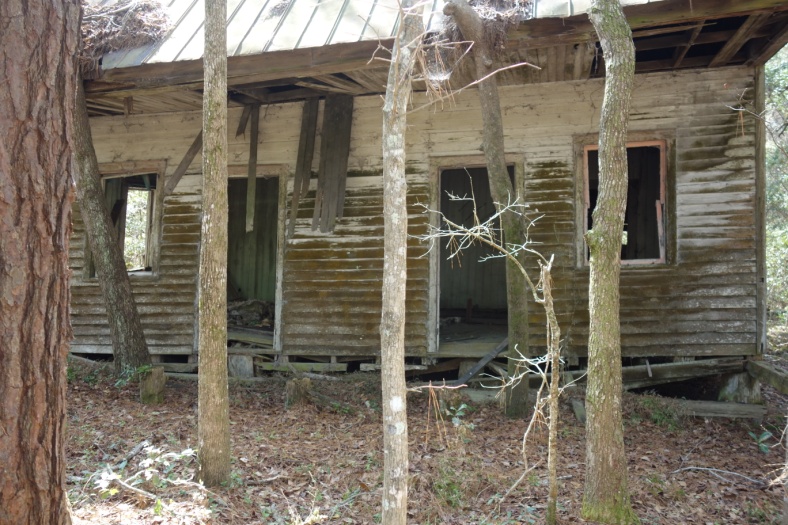
Abandoned Home, Mon Luis Island, Mobile County, Alabama
Photograph by Jo Garrett
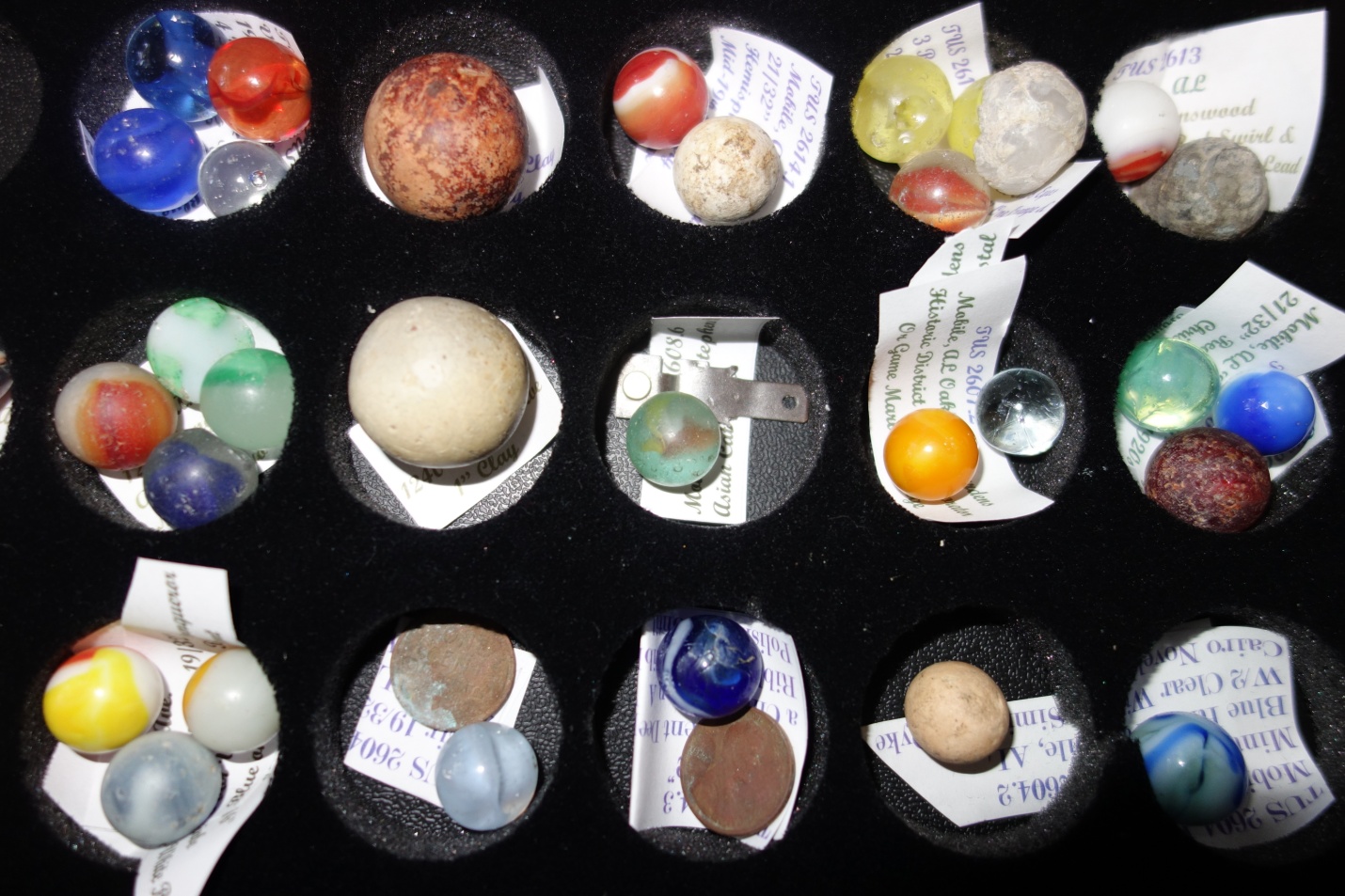 Free Coins!
Free Coins!
This story has simple premises. First, you can find marbles and all other sorts of artifacts on the surface. Some collectors call a surface survey looking for marbles “in the wild”. At least for us there is a lot of truth in that phrase!
Notice that we have some pennies in the box with the marbles. We have found dozens of wheat pennies over the years, and if any found marbles fit the same time period as the penny then we will often keep the coin with the penny as a time marker. For example, Peltier Marble “Victories” and “Conquerors” date to the late 1930s and especially through the World War II era. If we also find a penny on the same site and from the same time period then we will keep the two together.
On a dark and bitter cold night near Christmas in Mobile, Alabama, we found the oldest penny we have ever found: an 1865 in mint condition. The year 1865 was very notable for Mobile. From March 26 to April 9, the Union Army launched the Mobile Campaign to capture the city. Ironically, the Civil War ended on April 9th.
Important battles were fought across Mobile Bay at Spanish Fort and Fort Blakeley. Union forces captured Mobile on April 12, 1865[2]. That same year on May 25, 1865, during Federal occupation, an ordnance depot in Mobile exploded, killing around 300 people and also causing wide-spread destruction.
We certainly kept the penny, but we didn’t find any marbles to associate with it. We have also found a “V” nickel (1883 – 1913), Buffalo nickels (1913 – 1938), and two “Mercury” dimes.
We enjoy cleaning our marbles and other finds. Mobile dirt is generally very much like “midden soil” which is often associated with Native American camps and sites. This soil is black and very rich and is located where a home stood. This soil was under the house.
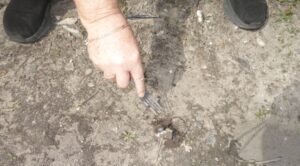
For us, throwing our “Orphan” Marbles’ in a box or jar is not an option.
Photograph by Jo Garrett
Many times in Mobile one or more homes stood on the same site for a century or more. ” Midden soil”, wherever found, is created by human activities. These heaps often contain organic materials like shells, bones, and other remnants of daily life like marbles. Over time, these materials break down and mix with the soil, creating a distinct layer of rich, fertile soil that can reveal valuable information about the diets, habits, and cultures of past human societies. So, almost everything we find on the surface, or scoop up with a nail or old tableware, is very dirty and needs a good cleaning.
We also record the marbles we find in an electronic catalog and then print out a line or two which tells the maker, if we know it, the size of the marble, its condition and whether or not it is a National Line Rainbow, a swirl, ribbon, and so on. We place the note, any coins, and “oddments” like buckles, hand wrought ox shoe nails, and so on together in a display box. We really enjoy seeing what we found once we get home. We sometimes call these our happy accidents! See our previous story Rock and Roll for details about how we store our marbles.
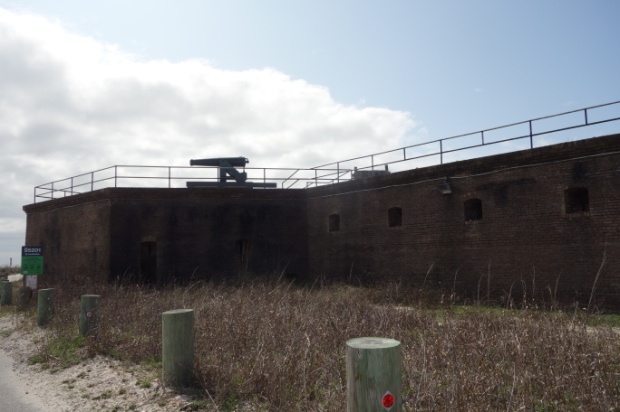
Photograph by Jo Garrett
Another Layer of History
Fort Gaines is on the east end of Dauphin Island, Alabama. This cannon is original to the Fort and is aimed at the Mobile Bay. The Fort was built in 1821 & it played a significant role in the Civil War Battle of Mobile Bay. The fort has a blacksmith shop, kitchens, and tunnels. It also houses a museum that details its history and the French colonial presence in the area. The site is considered one of the nation’s best-preserved Civil War-era masonry forts[3].
Every time we visit the east end of Dauphin Island we admire this handsome old fort and laugh at the time we were “shot” by a Fort re-enactor standing on a bulwark near this old cannon. We have visited the Fort many times and we are always happy when we “re-discover” it.
And yes, we have found a marble, a stone one, on the surface in another location on the island. At least we thought it was a marble. It is 5/8” and very smooth. We know that this is also the size of a .625 caliber musket ball. This caliber is not as common as others, such as the .69 caliber, but they did exist.

As imagined by Copilot
For example the little 5” barreled French ca. 1818 Model IX Flintlock Gendarmerie pistol, like this one imagined by Microsoft Copiolot,was .625 caliber[4].
The French first arrived on Dauphin Island, Alabama, in 1699. Pierre Le Moyne d’Iberville and his crew landed on the island while exploring the Gulf of Mexico. They established a presence on the island and used it as a strategic location for their colonial endeavors. Dauphin Island served as the seaport for the French colony of Louisiana and played a significant role in the early history of the region[5].
Again, almost every time we go looking for marbles right on the surface, we find something we weren’t looking for! Sometimes it is very mysterious and historical. And almost every time we go looking we get lost! For us that’s a big part of the fun. We don’t worry about a lot of gadgets and technology to find our way. We have been lost but, so far, always found our way home.
Don’ts & Dos When Surface Looking
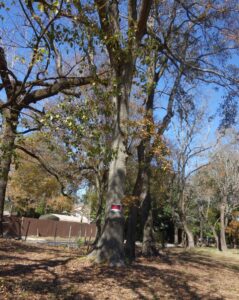
That sign is a bit hard to see, isn’t it? Many if not most signs like this are hard to see. Some are tiny and stuck in a window. Don’t overlook it! And don’t ever ignore it. It is probable that you will approach a lot from the back or side and not see the sign; look the lot over before any survey. Find the sign.
Remember, check the property carefully for signs like the “No Trespassing” nailed to this hickory nut tree. Anyone can buy and post a sign like this at the local dollar store. It is binding and, at least in Alabama, no more legal steps are required of the property owner. Similar to this one is “Private Property”.
“Posted No Trespassing” follows more legal requirements such as being posted at certain intervals around the property and it may also provide stronger grounds for prosecution by the property owner if you violate the warning.
In Alabama “Keep Out” is also legally binding. Before you set out you should go to a site like Criminal Law (https://legalclarity.org/alabama-trespassing-laws-what-you-need-to-know/?form=MG0AV3&form=MG0AV3/ “Alabama Trespassing Laws: What You Need to Know” and read the manual. Every State has such a site.
Never ever overlook any such signs and always search for them. The lot in this picture does not look promising for surface finds, but no matter how tempting it may be to sneak a peek just do don’t do it!
If you want to check a site for surface finds, posted or not, and there is a house nearby or adjacent to the lot then by all means ask the property owner. That is, ask if you are comfortable doing so. The owner of a property may be the adjacent neighbor or she or he may be more difficult to find. Regardless, it is always necessary to ask permission.
There is a nice double lot in an historic community which we search again and again after a hard rain or a storm. A part of this lot is privately owned. The yard is totally without grass, with no obvious indication of a yard, and it is un-posted. Still, Jo has asked the same lady twice if we can look and she said “yes” both times.

Be ready. Even with permission and no matter how quiet and unobtrusive you are, you almost certainly will be noticed. People are curious. When we explain that we are looking for marbles many seem people are incredulous, even after we show them the ones we have already found.
We were asked these same questions while deep in the sand deserts of Abu Dhabi, Sharjah, and Oman. While no one owned the desert there was local authority. When we showed local law enforcement, who invariably showed up, the oddments that we had found, including an ancient Indian heavy rupee, they, too, were incredulous and always asked “أين سيارتك؟” This means essentially “Where is your car?” In effect, they were confident that we were insane and that we would die out there beyond the fringe and they just wanted to make sure that they matched us to the right car when they hauled both us out of the desert.
Reactions may, or may not, be less dramatic but they are almost always the same. We won’t even tell you about the SWAT Team experience in Kissimmee, Florida! That’s another story altogether.
If you do ask for permission and you are refused then thank them and walk away. If you are at all uneasy about asking for permission then don’t ask. Walk away. Finally, you may simply not be welcomed in a community for whatever reasons. It doesn’t matter why[6]. If ever asked to leave a site then leave it. Even if you are confident that you have every right to be there. Leave.
Photograph by Joanne Garrett
Oakleigh House Museum, ca 1833 Greek Revival mansion, Mobile, Alabama
Sidewalks & Verges[7]
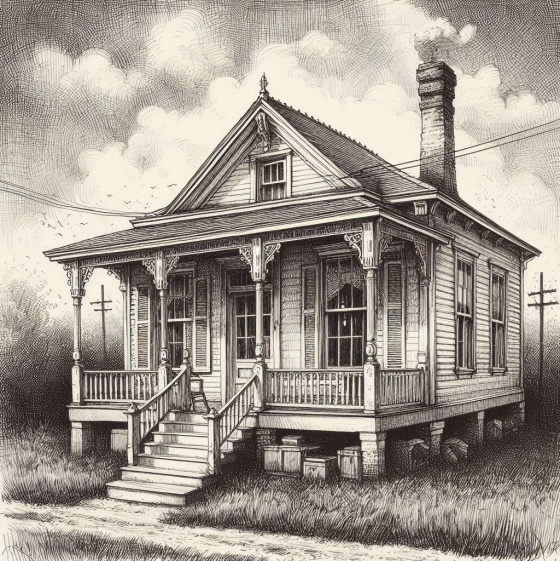
A Shotgun House as Imagined by Copilot
We have some gorgeous old communities in Mobile, such as Oakleigh Gardens and East Church Street. We never tire of walking the sidewalks here to let Larry’s service dog stretch her legs and to look at the architecture. There are any number of Carpenter Gothic, Steamboat Gothic, a few Plantation, Italianate, and Georgian styles.
Mixed in with this lot are “shotgun” houses which are believed to be influenced by African and Caribbean architectural styles. Now days many of these old homes, dating from about the time of the Civil War to 1920 or so, are being bought and lovingly restored.
These homes are longer than they are wide and, in popular lore, if the front and back doors are opened at the same time you can see all the way through the house. Another story is that you could fire a shotgun through the front door and out the back door without hitting anything or anybody.
Also notice in this sketch that the porch features carpenter fretwork or gingerbread trim and there is more trim under the house eve and on the pitch of the roof toward the front of the house. Today buyers treasure every bit of fretwork and, if possible, they repair it. We can’t imagine how difficult such trim would be to replace.
Finally, notice the large chimney. In Mobile most homes burned anthracite coal. This coal is very hard and black and it burns hot with fewer impurities. We often find fragments of this coal in the verges beside the streets and in the ash dumps from the homes.
And, we find marbles of all kinds in the verges along the sidewalks in front and beside all these types of homes. In Griffin, Georgia, Jo found a mint blue clay variegated jasper in easement beside the sidewalk where utility work had dug a hole and back filled it. It is the only variegated jasper — blue and white/gray clays swirled together by hand—that we have ever found.
In Pensacola, again at a back filled utility site by the street, we found a black ballot ball. These were used by many fraternal or community organizations to vote. Ballot boxes and white and black marbles have been used for centuries to decide on any number of internal, and even political, issues. This Pensacola black marble/ball had been at least four feet under the ground earlier.
In Mobile, we were walking along an ancient stone wall which formed the border to the inside verge of the sidewalk. Jo found a fantastic stone marble. It is remarkably old and we are sure that it is Antebellum.

Photograph by Jo Garrett
A Few Odds And Ends
We don’t know whether or not you have astounding trees where you live or travel, but we certainly do! In the East Church Street Community there is a very large Native American flint core which was often used for trade. The tree has almost completely surrounded it. And just look at this! Intellectually, we believe we know how this happened, but it certainly is a miracle, isn’t it?
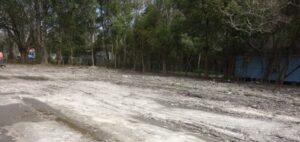
Our point is that while looking for places to survey for marbles don’t lose focus of what is all around you! Magnificent trees, flowers in season, changing of the leaves, the animals and birds all around, the architecture of the houses, and, especially the people.
How We Search When A Suitable Lot Has Been Found
This lot has just been cleared by the city after the home was condemned. We think that there were two homes, perhaps shotguns, on this large lot. Look carefully at the far right-hand side of the lot. This would be an ideal place to start your search.
This part of the lot contained sherds of ceramics. Once you’ve been at it for a while you can start to identify ceramic by type and this will give you a time marker to help you identify your marbles. There are a number of resources which you can read to help with identification: “Historical Archaeology Introduction to Ceramic Identification” (https://www.floridamuseum.ufl.edu/histarch/ceramic-types/introduction/?form=MG0AV3), “Think Like an Archaeologist Historic Ceramics” (PDF from https://www .southalabama.edu/org/archaeololgy/historic-ceramikcs.pdy/).
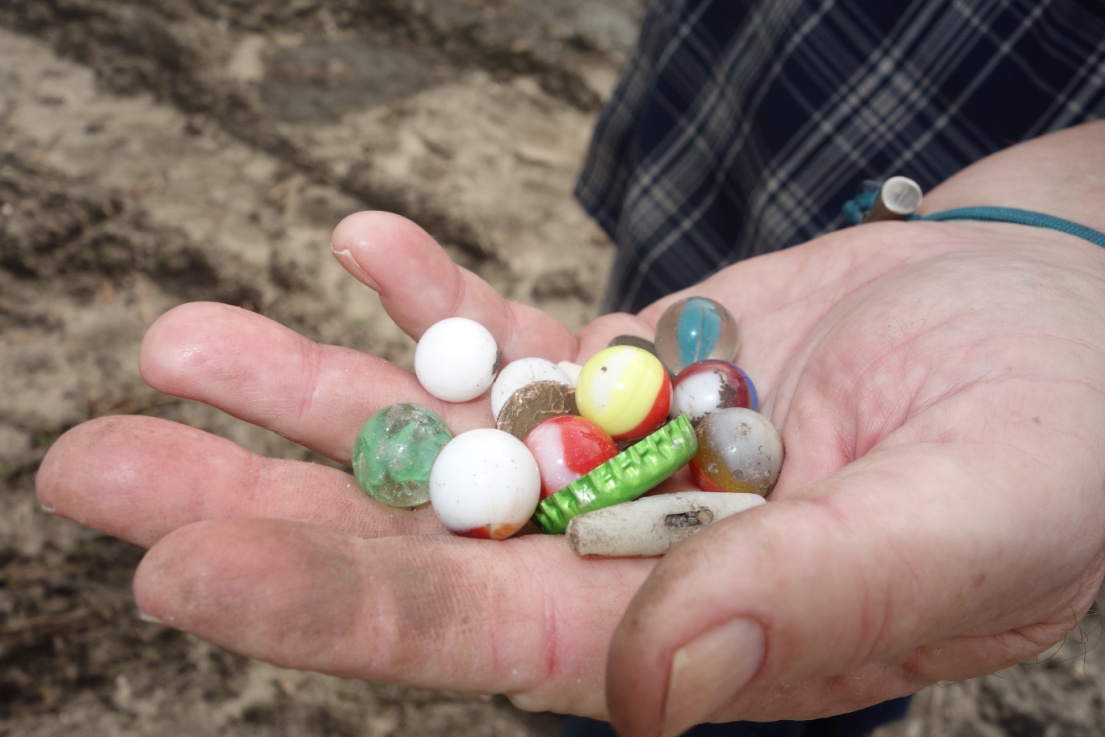
Photo by Jo Garrett
Here in Mobile we find a good bit of porcelain. We find by Chinese, which is typically very hard and skillfully painted and which dates to the 17th and 18th centuries. Remember, Mobile was settled in 1704.
British porcelain was possibly more treasured in Mobile than Chinese. It is softer and not as highly fired nor as highly and technically painted. And it was cheaper than Chinese porcelain. Here it dates to the Mid 18th century and after.[1]
If we find a large number of these two porcelains we know that the family who lived in the home did have financial resources at one time and we would expect to find stone and/or decorated clays. Of course, layers of living overlay each other which makes things even more interesting.
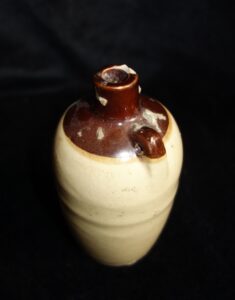
Little Brown Jug Found & Photographed by Jo Garrett
Another ceramic that we find a lot of is stoneware and salt glazed stoneware. Jo’s little brown jug is a two-tone stoneware whiskey jug which dates to the late 19th and early 20th centuries.
We also find whiteware. The key raw materials used in whiteware production are clay, feldspar, and silica. The slip is thin and it was bright white when buried. This ware was relatively inexpensive and it was introduced to America about 1820. We do and you almost certainly will, find hundreds of pieces of whiteware.
Another type of whiteware that we find is lustreware. Lustreware, is a type of pottery or porcelain with a metallic glaze that gives it an iridescent effect. It is very bright and shiny in the sunshine! You might want to compare whiteware and lusterware shards. Sometimes, especially in the foot pieces, you will see spots of blue pooling caused by the metallic additive which is usually tin. The foot is that little raised ring around the bottom of some dishes.
Most of the lusterware that we find dates to the late 19th and early 20th centuries and when found we think of about 1875 onward. This ceramic was inexpensive, and you would expect to find clay marbles on a site with lusterware and, just possibly, some German glass marbles.
You get the idea. Just like coins are time markers, so is ceramic. Study a bit and find out what is most common in your area and then put some time markers in mind when you go walkabout. And watch for oddities or uncommon pieces like tobacco spit glaze pottery which used a mixture of tobacco spit and urine, hand painted white and yellow ware, flow blue, brown, and green ceramic, and so on.
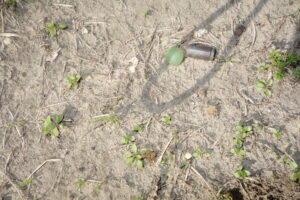
Photograph by Jo Garrett
Finally, there is one other time marker that we want to mention. Cartridges and bullets can be excellent time markers. We find Civil War-era bullets and pinfire, rimfire, and centerfire cartridges. All can be easily dated. Our bullet assortment is fairly small, but it represents time from the Fort Mims Massacre to present day. We once found a .45 caliber silver bullet! Weird. What were these bullets used for?
Features
Watch for archeological features on any site. These include the slight indentation where a home stood or where a cellar has been back filled. Marbles are often found in this slightly sunken area. You will always find one or more pits on any site. These are back filled (often not enough dirt was used and it sank) privies. One lot may have two or even more because most people dug new privies as needed.
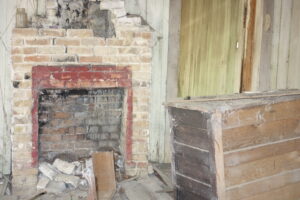 Hearth in the abandoned Home on Mon Luis Island, Mobile County, Alabama.
Hearth in the abandoned Home on Mon Luis Island, Mobile County, Alabama.
Photograph by Jo Garrett.
Depending on how long ago the original home was built, you may find a hearth. In Mobile we almost never find more than one feature left from a hearth. Remember the chimney in our sketch of a shotgun house? Well, most, but not all, of the lots we search burned coal in a stove. We find lots of ash piles created when the stove was cleaned out and loaded with fresh coal and we find features left from coal storage. The point is that marbles are often found near the place where the stove or fireplace stood.
 As imagined by Copilot
As imagined by Copilot
This is how Copilot imagines such a stove might look. Perhaps a bit too much detail, but you get the idea. The stove or fireplace was often the focal point of a home. In The Loop community of Mobile we found a beautiful celluloid die in the coal scuttle dump! Wonder what that back story is?
On many of the lots we search we find the remains of old wells. We have found open wells lined with brick, but this is uncommon. Be careful until you have located all of the features on the lot. We found a late 19th century hotel site recently in Coden, Alabama, which drew it’s water from a cement-lined cistern which has not been completely filled in. We imagine that, at least at one time, the cistern had marbles in the bottom!
You might find brick spall or whole brick. There is one large lot in downtown Mobile where a brick feature is evident if you search for it. We believe that this was the floor of a shop of some kind. Perhaps it was a blacksmith shop. We have not found a marble there, but we have found dozens of hand-wrought horse and ox nails which date to the Civil War era. We often find brick foundations.
On any lot see if you can find the old footings. These are about a foot square and were often made of brick. For some reason we often find marbles boot in the foundations and in or very near the footings. If you have enough brick to examine then it, too, can be a time marker. We often find slave-made brick made of local clays.[2]
A Few Closing Remarks
Remember, this is not a competition. If you get outside and enjoy the sun or the rain then you are in a win-win situation! We have looked for marbles in more than one tropical rain storm. Larry’s service dog has been right there looking for marbles with us! In fact, we found an unusual Southeast Asian coin floating in a water run during a storm!
You might not find much. In fact, we’ve had tremendous fun, met some nice people, and gobbled a soft-serve ice cream cone and found no marbles but still had a wonderful time!
But when you do find some nice old marbles, like the ¾” corn husk marble (ca. 1850 – 1880) which Jo pulled out of a foundation, or World War II Peltier, then that’s just icing on the cake.
Remember, finding the marbles is just the first step. Then you get to clean and identify them and for us both of these jobs are fun too. Don’t ever think that you are too disabled or too old to find marbles. Larry found one from inside the car once in Semmes, Alabama while leaning out the window! Give it a shot! Have fun!

As imagined by Copilot
Happy hunting!
“The best things in life are unexpected – because there were no expectations.” – Eli Khamarov
References
- Some successful archaeology projects do not involve digging other than just taking shovel tests. For one example see Robert Biasing, Principal Investigator & Donald Blakeslee, Project Director, Wichita State University, Archeological Survey of The Upper- Deep Creek Drainage, Kansas N.P.S. Grant Nos. 20-84-8305 and 20-85-9306-002, 1986. Here is an excerpt from the Abstract: During several periods from 1984 to 1986, a pedestrian survey of the upper Deep Creek Drainage, in Riley, Geary and Wabaunsee Counties of Kansas, was performed. The project area is in the northern Flint Hills, a few miles south of Manhattan on a tributary to the Kansas River. Because this drainage is a natural unit, small enough to be covered by the limited funding available yet rich in both historic and prehistoric sites, it was particularly well suited to a study of prehistoric human ecology. The survey covered portions of forty-eight sections with a land area equivalent of nearly thirty-seven sections. Two hundred and twenty-nine sites, twenty-one of which contained historic components, were recorded. Two hundred and twenty-one isolated finds were also recorded, and evidence for an “Indian trail” from the early historic period was located. Most of the sites found were directly related to prehistoric quarrying and/or to the trail. Most of the sites were confined to the surface, and very few of the lithics were diagnostic. Emphasis added https://www.academia.edu/38425857/Blasing1986_ArcheologicalSurveyOfTheUpperDeepCreekDrainage_Final_PDF?nav_from=ec6e25f8-6684-44c6-95e3-8af52dc5a0c2 2/22/2025 ↑
- https://en.wikipedia.org/wiki/Fort_Gaines_%28Alabama%29?form=MG0AV3 2/24/2025 ↑
- You might also want to check https://www.antonycribb.com/auction/lot/891-a-625-calibre-french-model-an-ix-flintlock-gendarmerie-pistol/?lot=2822 2/24/2025 ↑
- Dauphin has a long, and often very mysterious, past. If you want to read more then we recommend: https://soul-grown.com/the-mysterious-history-behind-alabamas-dauphin-island/?form=MG0AV3 (2/24/2025) & https://louisiane.cheminsdelafrancophonie.org/en/dauphin-island-alabama-where-everything-began/?form=MG0AV3 2/24/2025 ↑
- We were having a good time on a perfectly legal and searchable piece of property about dusk one day. Larry was Military Police in Vietnam and he stays 100% aware of our surroundings. We knew that an old man was on a corner of the same lot selling things which were somewhat less than legal. He was quiet. His customers were quiet. We were totally silent. This was the same day and same lot where we found that large stone marble in the feature photograph. It was simply lying there on the surface. Anyway, either the nearby “vendor” or his customers grew uneasy and he asked us to leave. It was hard to leave but we did. ↑
- We said that it is best practice to check out trespassing laws in your state. You should also check out the legal aspects of verges and public easement in your state. An example in Alabama is the Pdf “60.Streets-Alleys-and-Sidewalks-REVISED-2023” ↑
- You might want to check “Chipstone” @ https://www.chipstone.org/article.php/373/Ceramics-in-America-2007/English-Porcelain-in-America:-Evidence-from-Williamsburg?form=MG0AV3&form=MG0AV3 3/1/2025 ↑

